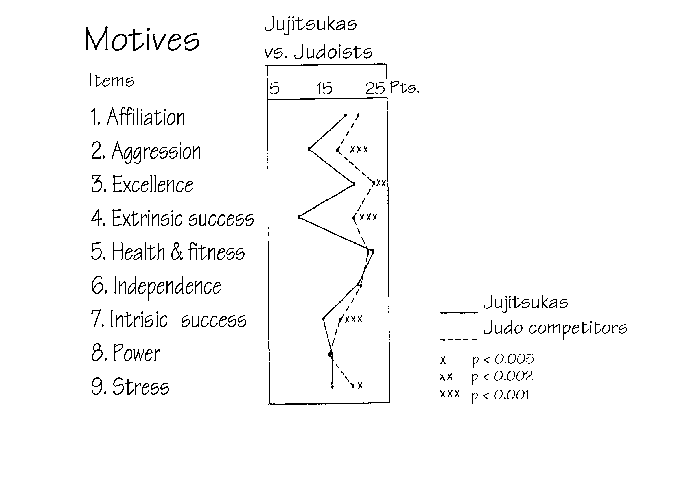by Dr. Stanislaw Sterkowicz |
| Years | 1 | 2 | 3 | 4 | 5 | 6 | above 7 | Total |
| n | 12 | 10 | 13 | 10 | 10 | 8 | 15 | 78 |
| % | 15.4 | 12.8 | 16.7 | 12.8 | 12.8 | 10.3 | 19.2 | 100 |
| Grade | 7th to 5th kyu | 4th to 2nd kyu | 1 kyu to 2 dan | . | . | . | . | Total |
| n | 18 | 35 | 25 | . | . | . | . | 78 |
| % | 23.1 | 44.9 | 32 | . | . | . | . | 100 |
As regard the aim of their training, 37% of them planned to improve Ju-Jitsu skills and to gain a higher degree of advancement (Kyu or Dan). Five groups were singled out: group one (19.2%) practising Ju-Jitsu two days a week, group two (43.5%) practising 3 days a week, group three (19.2%) practising 4 days a week, group four (12.8%) practising 5 days a week and in group five (5.1%) only four subjects trained 6 days weekly. Results and Disscussion1. The Motivation for beginning Ju-Jitsu There were seven detailed questions in the questionnaire which were ranked according to the number of the answers and are shown in Table 2. Table 2. Motive for beginning Ju-jitsu
Most of the people have started practising Ju-Jitsu because: 1) they have inclination to motor activities in an organized form, i.e. in groups in an instructor; 2) they have the need of the self-defence which Ju-Jitsu warrants; 3) they want improvement in terms of fitness self-control perserverance and ethics of self-defence proportional to the degree of danger. In this survey only 11.5% of the respondents were motivated after watching films about Martial Arts and Eastern Culture. Likewise the influence of radio broadcasts and TV programmes on the decision to take up Judo was on the third place on the “motivation scale ” with 16% in similar research conducted on Japanese judoists (Matsumoto 1984). 2. Participation Motives of the Ju-jitsukas and Judoists Twenty seven statements were formulated relating to the nine categories of incetives which might make an individual go to this activity. Unexpectedly, there was no correlation between the experience and the motives of the subjects. Therefore in my investigation I compared the motivation characteristics ofthe Ju-jitsuka (n = 78) with the group of top-class Polish Judoka (n = 25) for the sake of reference. It has been found out that the tested group (both Jujitsuka and Judo-men) evince both similar and dissimilar activity motives. They all share, in the same degree in the need of affiliation – involving opportunities for social intercourse, health and fitness, independence – involving opportunities to control their own situation, and power – involving opportunities to influence and control other people particularly their attitude, interests and opinions. It can be supposed, that the above-mentioned motives incline people who undertake and continue this kind of activity typified by an element of fighting, e.g. Ju-Jitsu and Judo. Significant differences between Jujitsukas and Judoka have also been indicated. The t-test analysis reveals that statistical significant differences have been found for: aggression – involving opportunities to intimidate or dominate other people, excellence – involving opportunities to do something very well for its own sake, extrinsic success pertaining to the deveIopment of a God-given talent e.i. achieving recognition, and pleasing family and friends; and stress – involving the excitement, tension, and pressure, which competition generated. Nobel prize winner Dr. Konrad Lorenz wrote in his famous work on aggression that fighting is an extremely spontanous action and in itself is the very proof of life. Simultaneously the ritual fight, like judo, may relieve aggression (Santschi 1985). In ConclusionSince Ju-Jitsu in Poland is not a competitive sport like Judo, the lower level of aggression, excellence, both extrinsic and intrinsic success, and stress characterize the Jujitsukas’ motivation. If instructors want to be real leaders of a Ju-Jitsu group they ought to know the motivation of individuals. Modification of the schooling methods may be necessary to meet individual learners’ wants and needs and set proper objectives for them. References
|
 “He who can suppress a moment’s anger may prevent many days’ sorrow.” |

